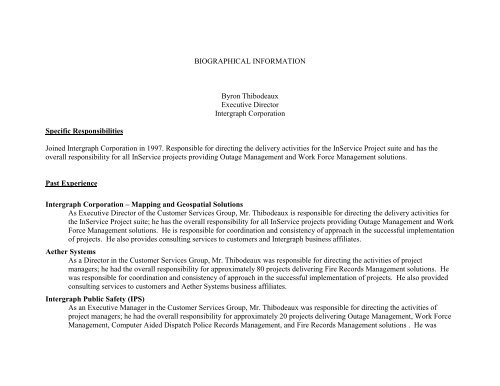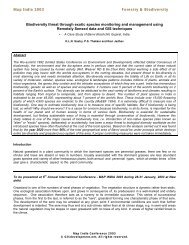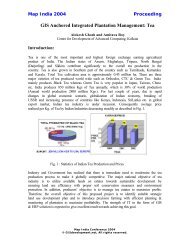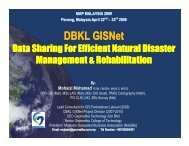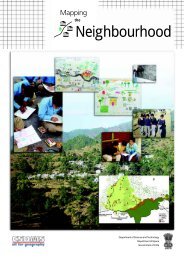People Make the Difference – Staff for Project Success
People Make the Difference – Staff for Project Success
People Make the Difference – Staff for Project Success
You also want an ePaper? Increase the reach of your titles
YUMPU automatically turns print PDFs into web optimized ePapers that Google loves.
BIOGRAPHICAL INFORMATION<br />
Byron Thibodeaux<br />
Executive Director<br />
Intergraph Corporation<br />
Specific Responsibilities<br />
Joined Intergraph Corporation in 1997. Responsible <strong>for</strong> directing <strong>the</strong> delivery activities <strong>for</strong> <strong>the</strong> InService <strong>Project</strong> suite and has <strong>the</strong><br />
overall responsibility <strong>for</strong> all InService projects providing Outage Management and Work Force Management solutions.<br />
Past Experience<br />
Intergraph Corporation <strong>–</strong> Mapping and Geospatial Solutions<br />
As Executive Director of <strong>the</strong> Customer Services Group, Mr. Thibodeaux is responsible <strong>for</strong> directing <strong>the</strong> delivery activities <strong>for</strong><br />
<strong>the</strong> InService <strong>Project</strong> suite; he has <strong>the</strong> overall responsibility <strong>for</strong> all InService projects providing Outage Management and Work<br />
Force Management solutions. He is responsible <strong>for</strong> coordination and consistency of approach in <strong>the</strong> successful implementation<br />
of projects. He also provides consulting services to customers and Intergraph business affiliates.<br />
Ae<strong>the</strong>r Systems<br />
As a Director in <strong>the</strong> Customer Services Group, Mr. Thibodeaux was responsible <strong>for</strong> directing <strong>the</strong> activities of project<br />
managers; he had <strong>the</strong> overall responsibility <strong>for</strong> approximately 80 projects delivering Fire Records Management solutions. He<br />
was responsible <strong>for</strong> coordination and consistency of approach in <strong>the</strong> successful implementation of projects. He also provided<br />
consulting services to customers and Ae<strong>the</strong>r Systems business affiliates.<br />
Intergraph Public Safety (IPS)<br />
As an Executive Manager in <strong>the</strong> Customer Services Group, Mr. Thibodeaux was responsible <strong>for</strong> directing <strong>the</strong> activities of<br />
project managers; he had <strong>the</strong> overall responsibility <strong>for</strong> approximately 20 projects delivering Outage Management, Work Force<br />
Management, Computer Aided Dispatch Police Records Management, and Fire Records Management solutions . He was
esponsible <strong>for</strong> coordination and consistency of approach in <strong>the</strong> successful implementation of projects. He also provided<br />
<strong>Project</strong> Management consulting services to customers and IPS business affiliates. His direct project experience includes <strong>the</strong><br />
following.<br />
• Fortaleza, Brazil. Mr. Thibodeaux served as <strong>the</strong> project manager consultant <strong>for</strong> <strong>the</strong> I/CAD <strong>Project</strong>.<br />
• Florida Power Corporation. Mr. Thibodeaux served as <strong>the</strong> project manager <strong>for</strong> <strong>the</strong> Outage Management System<br />
(OMS) <strong>Project</strong>.<br />
• City of Memphis, Tennessee. Mr. Thibodeaux served as <strong>the</strong> project manager <strong>for</strong> <strong>the</strong> I/CAD <strong>Project</strong>.<br />
• City of Homewood, Alabama. Mr. Thibodeaux served as <strong>the</strong> project manager <strong>for</strong> <strong>the</strong> I/CAD, I/LEADS, and<br />
I/FRMS <strong>Project</strong> and Fire Records Systems.<br />
• Shelby County, Alabama. Mr. Thibodeaux served as <strong>the</strong> project manager <strong>for</strong> <strong>the</strong> I/CAD and I/LEADS <strong>Project</strong>.<br />
• Licking County, Ohio. Mr. Thibodeaux served as <strong>the</strong> project manager <strong>for</strong> <strong>the</strong> I/LEADS <strong>Project</strong><br />
Science Applications International Incorporated, Huntsville, Alabama<br />
As a <strong>Project</strong> Management Consultant, Mr. Thibodeaux provided services to <strong>the</strong> Real Time Systems Group in areas of project<br />
management, proposal development, conceptual design, hardware procurement, and design implementation <strong>for</strong> Plant<br />
Monitoring, SCADA, and Security projects. Major projects included: <strong>the</strong> Duke Power Operator Aid Computer project<br />
replacing computer systems <strong>for</strong> seven Nuclear Units and three Simulators at three sites; <strong>the</strong> TVA Integrated Computer System<br />
<strong>Project</strong> providing turnkey design, procurement, and installation of a multi-unit plant monitoring system; and <strong>the</strong> Conoco<br />
Pipeline project providing a supervisory control system <strong>for</strong> <strong>the</strong> entire Conoco pipeline System in <strong>the</strong> U.S.<br />
Entergy Operations, Russellville, Arkansas<br />
As an Engineering Management Consultant, Mr. Thibodeaux assisted with major project assignments that were programmatic<br />
in nature. He was responsible <strong>for</strong> <strong>the</strong> development and implementation of programs aimed at prioritization and knowledgeable<br />
identification of assignment backlogs to manage engineering activity more effectively and efficiently.<br />
Gulf States Utilities, St. Francisville, Louisiana<br />
As Control Systems Supervisor, Mr. Thibodeaux directed <strong>the</strong> activities of a staff of engineers providing engineering support <strong>for</strong><br />
startup, operation, and maintenance of River Bend Station.<br />
Ethyl Corporation, Baton Rouge, Louisiana<br />
As Maintenance Supervisor, Mr. Thibodeaux directed and planned <strong>the</strong> activities of <strong>the</strong> Electrical, Instrument, and Painting<br />
maintenance <strong>for</strong>ces including supervision of construction activities.
Alabama Power Company<br />
As an Engineer, Mr. Thibodeaux was responsible <strong>for</strong> initial startup of protection and control systems <strong>for</strong> generating plants and<br />
EHV substations.<br />
Educational In<strong>for</strong>mation<br />
Master of Science in Operations Management; University of Arkansas<br />
Bachelor of Science in Electrical Engineering; Louisiana State University<br />
Professional Memberships<br />
Registered Professional Engineer - State of Louisiana #16822<br />
Senior Reactor Operator License - River Bend Station #41390<br />
Senior Member: IEEE
<strong>People</strong> <strong>Make</strong> <strong>the</strong> <strong>Difference</strong> <strong>–</strong> <strong>Staff</strong> <strong>for</strong> <strong>Project</strong> <strong>Success</strong><br />
Byron K Thibodeaux, Intergraph Corporation<br />
Over <strong>the</strong> many years I have spent working, predominantly in <strong>the</strong> area of software solutions development and deployment,<br />
one of <strong>the</strong> most consistent factors in determining <strong>the</strong> success of highly complex and broad enterprise impacting projects is<br />
<strong>the</strong> selection of <strong>the</strong> project team. The very success or failure of such a project can hinge on <strong>the</strong> selection of a project team<br />
with attributes conducive to success. The technical skills and knowledge are just some of <strong>the</strong> factors to be considered.<br />
Often more important and un<strong>for</strong>tunately <strong>the</strong> areas most often overlooked are <strong>the</strong> non technical factors that should be<br />
considered. While many companies have some sort of project organization to manage projects, much of <strong>the</strong> project<br />
staffing will typically be drawn from o<strong>the</strong>r organizations in order to meet <strong>the</strong> wide variety of skills and experience base<br />
required. For this reason it is important to consider <strong>the</strong> factors outlined below when selecting project team members.<br />
1. Corporate Culture Impacts<br />
Typically <strong>the</strong> corporate culture has tremendous impact upon <strong>the</strong> size and makeup of project teams as well as how <strong>the</strong>y<br />
view <strong>the</strong>ir role in <strong>the</strong> relationship with vendors. Just as individuals are influenced by <strong>the</strong>ir environments project teams tend<br />
to reflect <strong>the</strong> corporate attitudes as well. This is even true on a more microscopic level. Individuals will tend to reflect <strong>the</strong><br />
attitudes of <strong>the</strong>ir originating organizations.<br />
1.1. Autocratic vs. Committee<br />
Corporate cultures run <strong>the</strong> spectrum from very autocratic to extremely committee oriented in <strong>the</strong>ir approach to<br />
management and decision making. It is generally best that <strong>the</strong> project team reflect <strong>the</strong> corporate culture in this regard,<br />
not to mention <strong>the</strong> natural inclination to do so. A management structure that tends to be autocratic in nature will<br />
typically not have patience with a project organization that relies heavily on committee consensus in <strong>the</strong>ir approach to<br />
decision making. By <strong>the</strong> same token, a management structure that is predisposed to heavy committee involvement will<br />
have a tendency to be skeptical of decisions reached in a more autocratic manner by <strong>the</strong> project management.<br />
Typically a mixture of <strong>the</strong>se styles does not function well toge<strong>the</strong>r in a project team.<br />
1.2. Lean vs. Heavy<br />
Ano<strong>the</strong>r expression of corporate culture is <strong>the</strong> approach that is somewhat related to <strong>the</strong> management style preference<br />
discussed previously is how stakeholder representation is to be accomplished. While some companies favor a lean<br />
project organization with members expected to represent <strong>the</strong> interests of <strong>the</strong> various stakeholders even though <strong>the</strong>y
may not originate from <strong>the</strong>se organizations, o<strong>the</strong>rs prefer designated representation from each organization as<br />
members of <strong>the</strong> project team. <strong>Project</strong> staffing chosen should be com<strong>for</strong>table with <strong>the</strong> approach to be used.<br />
1.3. Degree of Latitude<br />
Are project members given wide degree of latitude in making decisions thus empowering <strong>the</strong>m to make those<br />
decisions in <strong>the</strong> best interest of <strong>the</strong> corporation or are <strong>the</strong>y merely charged with researching <strong>the</strong> alternatives <strong>for</strong><br />
presentation to <strong>the</strong> corporation decision making process? How a corporation views <strong>the</strong> project team’s responsibility<br />
with respect to this spectrum significantly influences <strong>the</strong> level of experience and abilities requisite in selecting staff <strong>for</strong><br />
<strong>the</strong> project team.<br />
1.4. Adversarial vs. Partnership Philosophy<br />
The corporation’s view of <strong>the</strong> relationship between <strong>the</strong>mselves and <strong>the</strong> solution provider dramatically impacts <strong>the</strong><br />
nature of <strong>the</strong> staff selected <strong>for</strong> <strong>the</strong> project team. Are vendors viewed as partners in technology and work practices<br />
advancement or predators primarily interested in maximizing profits and minimizing ef<strong>for</strong>ts? While ei<strong>the</strong>r extreme is<br />
probably an oversimplification of an individual corporation’s perspective, <strong>the</strong> corporation stance in this spectrum<br />
directly impacts expectations of <strong>the</strong> project team from that of complete team players to untrusting watchdogs to protect<br />
<strong>the</strong> corporate interest. In reality <strong>the</strong> project team should function somewhere within this spectrum wherein <strong>the</strong><br />
corporation is com<strong>for</strong>table with project team members generally reflecting <strong>the</strong> same general philosophy. However,<br />
wide diversity among project staff will be disruptive and should be avoided.<br />
2. Responsibility and Accountability<br />
It is essential that very clear lines of responsibility and accountability are established and en<strong>for</strong>ced in order that complex<br />
projects have an opportunity to manage and control <strong>the</strong> work environment in which <strong>the</strong>y exist. O<strong>the</strong>rwise <strong>the</strong> project team<br />
will be reduced to just reacting to many uncoordinated individual directives and never be able to establish a proactive<br />
approach to <strong>the</strong> solution deployment. While <strong>the</strong>re are pros and cons to line managed project implementation staffing<br />
versus matrixed organization approaches, ei<strong>the</strong>r approach can work it properly staffed and managed with clear direction,<br />
lines of authority and well defined accountability. Following are some areas to be aware of and to be on guard against<br />
when staffing project teams. Avoid selecting individuals with a propensity to contribute to <strong>the</strong>se factors.
2.1. Multiple Reporting Considerations<br />
Choose individuals who understand and are capable of accepting <strong>the</strong> fact that <strong>the</strong> established project organization will<br />
be responsible <strong>for</strong> <strong>the</strong> management of <strong>the</strong> project activities. While <strong>the</strong>y may report to a line manager and even have<br />
o<strong>the</strong>r duties if not assigned full time to <strong>the</strong> project, <strong>the</strong>y must be amenable to this concept. This is not to suggest that<br />
project team members should not represent <strong>the</strong>ir originating organizations and provide input from that perspective, but<br />
that activity must be within <strong>the</strong> context and within <strong>the</strong> guidelines established by <strong>the</strong> project. Individuals reporting to<br />
multiple organizations <strong>for</strong> <strong>the</strong> same tasks can only lead to confusion and in <strong>the</strong> worst case contradictory direction.<br />
2.2. Priority Assignments<br />
The establishment of priorities among tasks should be clear and straight <strong>for</strong>ward. This can be even more problematic<br />
<strong>for</strong> individuals not completely allocated to <strong>the</strong> project. It is important that <strong>the</strong> project organization be allowed to<br />
establish <strong>the</strong> priorities <strong>for</strong> <strong>the</strong> portion of an individual’s time that is allotted to <strong>the</strong> project. If that is not <strong>the</strong> case <strong>the</strong><br />
tendency is <strong>for</strong> <strong>the</strong> project to get short changed or not achieve <strong>the</strong> desired results. Control over priority assignment is<br />
essential to <strong>the</strong> project organization’s accomplishment of <strong>the</strong> desired results with <strong>the</strong> resources assigned and project<br />
staffing selections should be amenable.<br />
2.3. Power Struggles<br />
Nothing can be more detrimental to a project’s success that internal power struggle. This can be motivated not only by<br />
individuals seeking power, but also by strong pressure from outside groups to have representatives to control project<br />
activities. For this reason it is important to have <strong>the</strong> goals and scope of <strong>the</strong> project well defined prior to commencement<br />
<strong>for</strong> <strong>the</strong> types of projects that have impact across <strong>the</strong> enterprise. The processes <strong>for</strong> change control and scope<br />
management need to be well established and adhered to or this area will become a battleground where <strong>the</strong> corporate<br />
compromises required to field an enterprise level software solution will be fought over and over again. It is imperative<br />
that everyone understands that <strong>the</strong> project is to be executed to achieve results that are in <strong>the</strong> corporation’s best<br />
interest and <strong>the</strong> project team must buy in to this philosophy even though this may be in conflict with individual groups’<br />
best interest. The project should be staffed with personnel that do not use <strong>the</strong>ir position in <strong>the</strong> project to promote <strong>the</strong>ir<br />
originating groups self interest to <strong>the</strong> detriment of <strong>the</strong> overall project.
2.4. Conflicting Agendas<br />
Related to <strong>the</strong> issue of power struggles is <strong>the</strong> issue of conflicting agendas. While quiet often a power struggle can be<br />
innocently occasioned by well meaning individuals, this is often caused by individuals who have a bias toward differing<br />
outcomes that is promoted in all <strong>the</strong>ir decisions or actions. This can be a result of individual bias or an inordinate<br />
sensitivity to a particular organization’s desires. There is a difference between representing an organization’s interests<br />
and trying to subvert <strong>the</strong> end result to supplant <strong>the</strong> project goals and scope with alternate goals and scope that favor<br />
one organization at <strong>the</strong> expense of <strong>the</strong> overall project outcome. Every organization has interests which may have to<br />
become secondary to <strong>the</strong> overall interest of <strong>the</strong> corporation in <strong>the</strong> deployment of enterprise level software solutions.<br />
Individuals chosen to staff <strong>the</strong> project should be able to operate within <strong>the</strong> project guidelines and scope while<br />
representing <strong>the</strong> interests of <strong>the</strong>ir originating organization.<br />
3. User Community Considerations<br />
Without a doubt one of <strong>the</strong> essential criteria <strong>for</strong> how positively a deployed solution will be viewed after <strong>the</strong> project is over is<br />
<strong>the</strong> adequacy of end user representation during <strong>the</strong> project. Due to <strong>the</strong> complexity and broad impact of <strong>the</strong> solution many<br />
decisions and compromises are typically involved in <strong>the</strong> course of <strong>the</strong> project. It is imperative that <strong>the</strong> end users feel that<br />
<strong>the</strong>y had a voice in <strong>the</strong>se decisions ei<strong>the</strong>r through direct representation or by affirmed champions.<br />
3.1. End Users<br />
In order to achieve <strong>the</strong> benefits anticipated by any enterprise level solution it is imperative that <strong>the</strong> end users feel that<br />
<strong>the</strong>ir needs and desires were considered during project implementation. Usually <strong>the</strong> best way to accomplish this is to<br />
include some end users in <strong>the</strong> project team (usually as Subject Matter Experts). For <strong>the</strong> selection of <strong>the</strong>se individuals<br />
to be effective, <strong>the</strong> individuals must be knowledgeable, respected by <strong>the</strong>ir peers, and capable of working in a team<br />
environment. Active involvement by such qualified end users’ is <strong>the</strong> first step to acceptance.<br />
3.2. End User Management<br />
Although <strong>the</strong> end user management team may not directly use <strong>the</strong> software solution, <strong>the</strong> introduction of <strong>the</strong> new<br />
solution has direct impact on <strong>the</strong>ir ability to manage <strong>the</strong>ir organization and <strong>the</strong> attitudes and activities of <strong>the</strong>ir<br />
work<strong>for</strong>ce. Representation from this sector of <strong>the</strong> end user community should not be neglected. The same<br />
considerations employed in selecting end user participation should be employed.
3.3. Data Users<br />
There is an aspect of <strong>the</strong> deployment of most software solutions now that involves <strong>the</strong> collection of data that is ei<strong>the</strong>r<br />
used real time or at some later point by o<strong>the</strong>rs in <strong>the</strong> per<strong>for</strong>mance of <strong>the</strong>ir jobs. While <strong>the</strong>se individuals may not be<br />
considered end users, <strong>the</strong>ir input is also vital to <strong>the</strong> overall success of <strong>the</strong> delivered solution. The solution should<br />
collect <strong>the</strong> in<strong>for</strong>mation needed and provide it in a manner that is readily usable. Once again representation by<br />
knowledgeable, respected, team oriented individuals will be an asset to <strong>the</strong> success of <strong>the</strong> delivered solution.<br />
3.4. Externally Interfaced Systems Owners<br />
As <strong>the</strong> impact of <strong>the</strong>se types of solutions becomes broader, <strong>the</strong> likelihood of interfaces to external systems increases.<br />
These interface points become key areas that really determine how much enterprise level benefit can be achieved. It is<br />
becoming more and more important that <strong>the</strong> delivered solutions not only solve problems or provide enhancements in<br />
isolated departments but also provide workflow and data capture improvements across <strong>the</strong> enterprise. Hence <strong>the</strong><br />
inclusion of individuals who are knowledgeable of <strong>the</strong>se external system workings and needs is very important to<br />
insure that <strong>the</strong> benefits can be maximized across <strong>the</strong> enterprise. As be<strong>for</strong>e, representation by knowledgeable,<br />
respected, team oriented individuals will be an asset to <strong>the</strong> success of <strong>the</strong> delivered solution.<br />
3.5. Understanding of <strong>the</strong> Capabilities <strong>–</strong> Expectations<br />
It is important that involved external departments are well versed on <strong>the</strong> capabilities and expectations of <strong>the</strong> new<br />
solution. This education is a key role of <strong>the</strong>ir project representatives. It is not enough that <strong>the</strong>y merely represent <strong>the</strong><br />
respective departments. They must act as ambassadors and educators <strong>for</strong> <strong>the</strong> new solution.<br />
3.6. Change Management Impact<br />
Effective change management is an essential part of successful deployment of any new solution. An understanding of<br />
not only what <strong>the</strong> new system(s) will do but also <strong>the</strong> impact upon <strong>the</strong> organizations is key to how <strong>the</strong> new solution will<br />
be perceived and accepted. It is important that <strong>the</strong> change management ef<strong>for</strong>t begin during <strong>the</strong> early stages of <strong>the</strong><br />
project.<br />
3.7. Set/Manage Expectations<br />
It is definitely better to proactively set and manage expectations ra<strong>the</strong>r than to just allow <strong>the</strong>m to develop. In a<br />
business climate no one likes surprises. Typically <strong>the</strong> more lead time individuals and organizations have <strong>the</strong> more<br />
likely a favorable reaction. A critical function of <strong>the</strong> project team is to plan and execute a program to establish <strong>the</strong>
expectations related to <strong>the</strong> final solution delivery as well as any interim steps. The unknown is usually feared; hence<br />
education is often <strong>the</strong> best aid to managing expectations. <strong>Project</strong> team representation should be selected with this<br />
facet in mind. As always individuals respected by <strong>the</strong>re peers are usually <strong>the</strong> best individuals to accomplish this task.<br />
3.8. Buy In<br />
Obviously one of <strong>the</strong> ultimate goals of any project is to achieve wide spread buy in. The various user groups can be<br />
considered <strong>the</strong> project teams “customers”. In order <strong>for</strong> <strong>the</strong> project to be considered a success <strong>the</strong>se “customers” must<br />
“sign off” on <strong>the</strong> delivered solution. The best way to achieve this is to get <strong>the</strong> various users involved early and create in<br />
<strong>the</strong>m a sense of ownership. This means that <strong>the</strong> various user communities have to be involved in project decisions<br />
and feel that <strong>the</strong>y have real input and impact into <strong>the</strong> process. In addition to functionality decisions, <strong>the</strong>y will be acutely<br />
interested in roll out strategies and priority setting.<br />
4. Peripheral Users Influence<br />
Quite often a significant factor in <strong>the</strong> overall success of <strong>the</strong> delivered solution is <strong>the</strong> perception of peripheral users.<br />
Because <strong>the</strong>se users can be wide spread throughout <strong>the</strong> organization, <strong>the</strong>re opinions may actually receive more notice<br />
than <strong>the</strong> main users of <strong>the</strong> solution. For <strong>the</strong>se reasons as well <strong>the</strong> desire to maximize <strong>the</strong> return on what is usually a<br />
considerable investment in time and resources it is important that this broad community have adequate representation in<br />
<strong>the</strong> project team. That representation should be prepared to address <strong>the</strong> following issues in crafting delivered solution as<br />
well as being able to sell <strong>the</strong> solution to <strong>the</strong> respective user communities.<br />
4.1. Quality of Data Input<br />
It is imperative that <strong>the</strong> data that comes from external sources be accurate and appropriate <strong>for</strong> <strong>the</strong> use intended. For<br />
that reason it is important that individuals knowledgeable in <strong>the</strong> external sources and <strong>the</strong> use within <strong>the</strong> solution be<br />
part of <strong>the</strong> project team to insure that <strong>the</strong>re is no data mismatch.<br />
4.2. Reliability of Interfaced Data Sources<br />
Since quite often <strong>the</strong> business processes that are supported by <strong>the</strong> project solution are required to have a high<br />
availability, <strong>the</strong> reliability of <strong>the</strong> external data sources must be considered. Knowledgeable individuals must be involved<br />
in <strong>the</strong> design of <strong>the</strong>se interfaces in order to allow <strong>the</strong> solution to provide commensurate availability. The very best<br />
solution functionality can be rendered ineffectual if <strong>the</strong> input source data or output data to external systems is not<br />
available.
4.3. Flexibility in <strong>the</strong> Final Interface Solution<br />
Almost without exception in <strong>the</strong> development of enterprise wide solutions <strong>the</strong>re are some work process changes that<br />
must be employed. Most of <strong>the</strong>se are generally process improvements that increase overall efficiency and quality.<br />
However <strong>the</strong>re will be some changes that are necessary to interface <strong>the</strong> many different systems. The project team<br />
members need to have some flexibility in crafting <strong>the</strong> various interfaces in order to achieve <strong>the</strong> optimal results. The<br />
overall goal is to improve <strong>the</strong> corporate per<strong>for</strong>mance. In some instances compromises will be required in order to allow<br />
this goal to be achieved.<br />
5. Typical <strong>Project</strong> Team Composition<br />
Because of <strong>the</strong> complex nature of <strong>the</strong>se types of projects and <strong>the</strong> broad effects throughout <strong>the</strong> organization <strong>the</strong> project<br />
team representation has a tendency to be ra<strong>the</strong>r broad. While <strong>the</strong> size of <strong>the</strong> company and o<strong>the</strong>r factors may impact <strong>the</strong><br />
precise number of individuals and amount of time devoted to <strong>the</strong> project, <strong>the</strong> areas of expertise need to be represented in<br />
order to ensure that all <strong>the</strong>se areas are considered. Some of <strong>the</strong> following are individuals that will be needed to support<br />
<strong>the</strong> software solution once deployed that should be considered as part of <strong>the</strong> project team. While <strong>the</strong>se individuals may<br />
not be part of <strong>the</strong> core team <strong>the</strong>y are certainly individuals who are necessary <strong>for</strong> <strong>the</strong> overall success of <strong>the</strong> deployed<br />
solution. A solution that can not be adequately supported will not be a successful solution no matter how much<br />
functionality it provides. For that reasons representatives <strong>for</strong> some of <strong>the</strong> following areas should be considered as part of<br />
<strong>the</strong> project team even though in some cases <strong>the</strong>ir participation may only be part time. Depending upon <strong>the</strong> nature of <strong>the</strong><br />
software solution o<strong>the</strong>r representation may be appropriate as well.<br />
5.1. <strong>Project</strong> Manager<br />
The <strong>Project</strong> Manager will coordinate all activities on <strong>the</strong> <strong>Project</strong>. This person will provide <strong>the</strong> technical vision <strong>for</strong> <strong>the</strong><br />
<strong>Project</strong> and assure that this is consistent with <strong>the</strong> overall corporate direction. The <strong>Project</strong> Manager will be responsible<br />
<strong>for</strong> communications with executives and coordinate any support requirements from <strong>the</strong> executive team.<br />
5.2. System Administrator<br />
The System Administrator will be responsible <strong>for</strong> working with <strong>the</strong> vendor to coordinate and support <strong>the</strong> installation and<br />
configuration of <strong>the</strong> project software. This person must be capable of managing <strong>the</strong> configurations of <strong>the</strong> system to
assure that <strong>the</strong> System does not have any mismatches of Software versions as well as provide day to day system<br />
management.<br />
5.3. Database Administrator<br />
The customer’s Database Administrator is primarily responsible <strong>for</strong> <strong>the</strong> configuration of data base and maintaining <strong>the</strong><br />
<strong>Project</strong> data in that environment. This person should be experienced with data base systems and all of <strong>the</strong> details<br />
surrounding <strong>the</strong> care and maintenance of this data. Specifically, this person will monitor database characteristics such<br />
as per<strong>for</strong>mance, fragmentation, size, etc<br />
5.4. Application Analyst(s)<br />
The Application Analyst typically comes from In<strong>for</strong>mation Technology (IT) department and has proficient in software<br />
programming. Experience with <strong>the</strong> programming languages and data base used by <strong>the</strong> software solution is extremely<br />
beneficial. This person(s) will be involved in <strong>the</strong> design phase of <strong>the</strong> project and will need to be <strong>the</strong> recipient an<br />
appropriate level of knowledge transfer during <strong>the</strong> course of <strong>the</strong> <strong>Project</strong> to acquire <strong>the</strong> necessary skills to maintain and<br />
support <strong>the</strong> system.<br />
5.5. Network Administrator<br />
The Network Administrator is primarily responsible <strong>for</strong> <strong>the</strong> configuration of <strong>the</strong> network and coordinating <strong>the</strong> system’s<br />
inclusion in <strong>the</strong> corporate network environment. This person should be experienced with network equipment and all of<br />
<strong>the</strong> details surrounding <strong>the</strong> care and maintenance of <strong>the</strong> software solution in <strong>the</strong> corporate network.<br />
5.6. Subject Matter Expert(s)<br />
The Subject Matter Experts (SMEs) collect and verify all company specific data <strong>for</strong> <strong>the</strong> system <strong>for</strong> application in <strong>the</strong><br />
software solution environment. These individuals will be used in <strong>the</strong> upfront define and design phases of <strong>the</strong> project<br />
and can also serve as system testers during <strong>the</strong> build and deliver phases of <strong>the</strong> project. SMEs can also be involved in<br />
end user training and serve as frontline support during <strong>the</strong> maintenance and support phases of <strong>the</strong> project. Because<br />
<strong>the</strong>se people have been chosen to speak <strong>for</strong> <strong>the</strong>ir peers, <strong>the</strong>y should be well respected and noted experts in <strong>the</strong>ir<br />
fields.
5.7. System Trainer(s)<br />
With highly complex systems and corresponding investment it is imperative that personnel are educated in <strong>the</strong><br />
complete capabilities. The System Trainer(s) becomes a system expert <strong>for</strong> on-going training of new personnel and<br />
refresher training as needed. Each supported group should have a designated trainer to support on-going user needs.<br />
6. Example <strong>Project</strong> Teams<br />
Because of <strong>the</strong> complex nature of <strong>the</strong>se types of projects and <strong>the</strong> broad effects throughout <strong>the</strong> organization <strong>the</strong> project<br />
team representation has a tendency to be ra<strong>the</strong>r broad. While <strong>the</strong> size of <strong>the</strong> company and o<strong>the</strong>r factors may impact <strong>the</strong><br />
precise number of individuals and amount of time devoted to <strong>the</strong> project, <strong>the</strong> areas of expertise needed to support <strong>the</strong><br />
software solution once deployed should also be considered as part of <strong>the</strong> project team. While <strong>the</strong>se individuals may not<br />
be part of <strong>the</strong> core team <strong>the</strong>y are certainly individuals who are necessary <strong>for</strong> <strong>the</strong> overall success of <strong>the</strong> deployed solution.<br />
A solution that can not be adequately supported will not be a successful solution no matter how much functionality it<br />
provides. Examples of project staffing <strong>for</strong> some recent projects are depicted in <strong>the</strong> following charts.
InService <strong>Project</strong><br />
Executive Sponsor<br />
Outage Management<br />
<strong>Project</strong> Manager<br />
Work<strong>for</strong>ce Management<br />
<strong>Project</strong> Manager<br />
Vendor<br />
<strong>Project</strong> Manager<br />
OMS<br />
GIS Conversion<br />
Team Lead<br />
OMS<br />
Transition<br />
Team Lead<br />
OMS/WFMS<br />
System Functionality<br />
Team Lead<br />
OMS/WFMS<br />
Infrastructure<br />
Team Lead<br />
OMS/WFMS<br />
Interfaces<br />
Team Lead<br />
WFMS<br />
Testing & Production<br />
Team Lead<br />
WFMS<br />
Transition<br />
Team Lead<br />
<br />
<br />
<br />
<br />
GIS data publish routine<br />
design<br />
Road map configuration<br />
Map maintenance<br />
Map usability (locates,<br />
queries, levels, views,<br />
etc.)<br />
<br />
<br />
<br />
<br />
<br />
Deployment<br />
Testing<br />
Training<br />
Process change<br />
management<br />
Documentation<br />
<br />
<br />
<br />
<br />
<br />
<br />
<br />
<br />
<br />
<br />
InService dispatch<br />
configuration<br />
I/mobile configuration<br />
Crew management setup<br />
Data collection<br />
Mobile mapping<br />
Develop supplemental<br />
<strong>for</strong>ms<br />
Reporting<br />
System administration<br />
Database configuration<br />
and administration<br />
Security<br />
Network configuration<br />
HW/SW installation<br />
Radio network analysis/<br />
management<br />
MDT installation<br />
GPS installation<br />
<br />
<br />
<br />
<br />
<br />
<br />
<br />
<br />
<br />
I/Call (CIS,IVR,21st)<br />
I/Work (MIMS)<br />
I/MDT<br />
I/SCADA (Electric)<br />
I/Page<br />
I/Mail<br />
I/Callback<br />
I/Tracker (GPS)<br />
Emergency outage<br />
system<br />
<br />
<br />
<br />
<br />
Plan acceptance testing<br />
Work w/Integration to<br />
develop system test plan<br />
Plan system cutover<br />
Develop production<br />
support plan<br />
<br />
<br />
<br />
<br />
Coordinate training<br />
and documentation<br />
Plan MDT and<br />
workstation rollout<br />
Business process<br />
coordination<br />
Conversion of<br />
legacy users
InService <strong>Project</strong><br />
Executive Sponsor<br />
Outage Management<br />
<strong>Project</strong> Manager<br />
Work<strong>for</strong>ce Management<br />
<strong>Project</strong> Manager<br />
Vendor<br />
<strong>Project</strong> Manager<br />
OMS<br />
GIS Conversion<br />
Team Lead<br />
OMS/WFMS<br />
Transition<br />
Team Lead<br />
OMS/WFMS<br />
System Functionality<br />
Team Lead<br />
OMS/WFMS<br />
Infrastructure<br />
Team Lead<br />
OMS/WFMS<br />
Interfaces<br />
Team Lead<br />
WFMS<br />
Testing & Production<br />
Team Lead<br />
<br />
<br />
<br />
<br />
GIS data publish routine<br />
design<br />
Road map configuration<br />
Map maintenance<br />
Map usability (locates,<br />
queries, levels, views,<br />
etc.)<br />
<br />
<br />
<br />
<br />
<br />
<br />
<br />
<br />
<br />
Deployment<br />
Testing<br />
Training<br />
Process change<br />
management<br />
Documentation<br />
Coordinate training<br />
and documentation<br />
Plan MDT and<br />
workstation rollout<br />
Business process<br />
coordination<br />
Conversion of legacy<br />
users<br />
<br />
<br />
<br />
<br />
<br />
<br />
<br />
<br />
<br />
<br />
InService dispatch<br />
configuration<br />
I/mobile configuration<br />
Crew management setup<br />
Data collection<br />
Mobile mapping<br />
Develop supplemental<br />
<strong>for</strong>ms<br />
Reporting<br />
System administration<br />
Database configuration<br />
and administration<br />
Security<br />
<br />
<br />
<br />
<br />
<br />
Network configuration<br />
HW/SW installation<br />
Radio network analysis/<br />
management<br />
MDT installation<br />
GPS installation<br />
<br />
<br />
<br />
<br />
<br />
<br />
<br />
<br />
<br />
I/Call (CIS,IVR,21st)<br />
I/Work (MIMS)<br />
I/MDT<br />
I/SCADA (Electric)<br />
I/Page<br />
I/Mail<br />
I/Callback<br />
I/Tracker (GPS)<br />
Emergency outage<br />
system<br />
<br />
<br />
<br />
<br />
Plan acceptance testing<br />
Work w/Integration to<br />
develop system test plan<br />
Plan system cutover<br />
Develop production<br />
support plan


